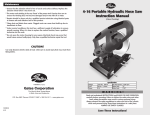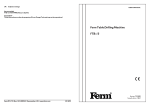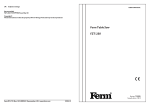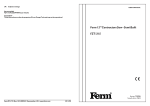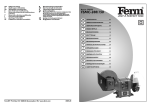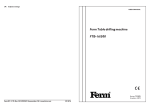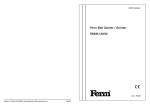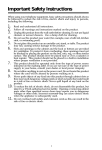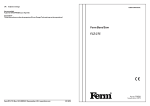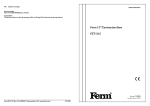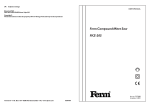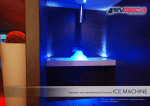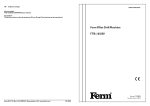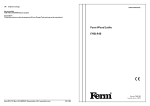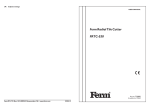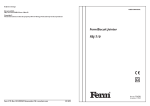Download Ferm Saw Bench FZT-250N
Transcript
UK Subject to change USER’S MANUAL Ferm Saw Bench FZT-250N Art.nr. 720120 Screwfix art.nr: 97825 Ferm • P.O. Box 134 • 8280 AC Genemuiden-NL • Web: www.ferm.nl 0208/28 UK English Saw Bench SAFETY INSTRUCTIONS The following symbols are used in these instructions for use: Denotes risk of personal injury, loss of life or damage to the tool in case of non-observance of the instructions in this manual. Denotes risk of electric shock. Carefully read this manual before using the machine. Make sure that you know how the machine functions and how to operate it. Maintain the machine in accordance with the instructions to make sure it functions properly. Keep this manual and the enclosed documentation with the machine. Electrical safety Warning! When using electric tools, basic safety precautions should always be followed to reduce the risk of fire, electric shock and personal injury. Read all these instructions before attempting to operate this product and save these instructions. Always check that the voltage corresponds to the voltage on the rating plate. Replacing cables or plugs Immediately throw away old cables or plugs when they have been replaced by new ones. It is dangerous to insert the plug of a loose cable in the wall outlet. Using extension cables Only use an approved extension cable suitable for the power input of the machine. The minimum conductor size is 1.5 mm2. When using a cable reel always unwind the reel completely. GENERAL SAFETY INSTRUCTIONS Warning! When using electric tools, basic safety precautions should always be followed to reduce the risk of fire, electric shock and personal injury, including the following. Read all these instructions before attempting to operate this product. Retain for future refence. 1. Keep work area clear. Cluttered areas and benches invite injuries. 2. Consider work area environment. Do not expose power tools to rain. Do not use power tools in damp or wet locations. Keep work area well lit. Do not use power tools in presence of flammable liquids or gases. 2 3. Guard against electric shock. Prevent body contact with grounded surfaces (e.g. pipes, radiators, refrigerators). 4. Keep children away. Children should be kept away from the work area at all times. Do not let children handle the Electric Rotary Hammer Drill at any time. 5. Store unused tools. When not is use keep tools out of reach of children. Store in a dry and secure location. 6. Do not force tool. Do not apply undue pressure as this may affect performance and may cause damage to the machine. Forcing the job also increases the potential for accidents. 7. Use right tool. Do not force small tools or attachments to do the job of heavy duty tool. Do not use a Angle Grinder for purposes not intended. 8. Dress properly. Do not wear loose clothing or Jewellery. They can be caught in moving parts. Rubber gloves and nonskid footwear are recommended when working outdoors. Wear protective hair covering to contain long hair. 9. Use safety glasses. Also use face or dust mask if cutting operation is dusty. 10.Do not abuse cord. Never carry tool by cord or yank it to disconnect it from electrical socket. Keep cord from heat, oil and sharp edges. 11.Secure work. Use clamps or a vice to hold work. It’s safer than using your hand and it frees both hands to operate tool. 12.Do not overreach. Keep proper footing and balance at all times. 13.Maintain tools with care. Keep tools sharp and clean for better and safer performance. Follow instructions for lubricating and changing accessories. Inspect tool cords periodically and, if damaged, have repaired by authorized service facility. Inspect extension cords periodically and replace if damaged. Keep handles dry, clean and free from oil and grease. 14.Disconnect tools. When not in use, before servicing, and when changing accessories such as blades, bits and cutters. 15.Remove adjusting keys and wrenches. Form the habit of checking to see that keys and adjusting wrenches are removed from tool before turning it on. 16.Avoid unintentional starting. Do not carry plugged-in tools with finger on switch. Be sure switch is off when plugging in. 17.Outdoor use extension cords. When tool is used outdoors, use only extension cords intended for use outdoors and so marked. Always use tool in conjunction with a residual circuit breaker device. 18.Stay alert. Watch what you are doing. Use common sense. Do not operate tool when you are tired. 19.Check damaged parts. Before further use of the tool, a guard or other part Ferm EXPLODED VIEW Ferm 11 SPARE PARTS REF.NR. 407820 407821 407402 407428 407405 407822 407838 407823 407824 407826 407827 407828 407408 407830 407411 407831 407829 407825 407832 407833 407414 407834 407835 407836 806202 806204 407837 10 DESCRIPTION POWER SWITCH GEAR LIFTINGWHEEL COMPLETE LOCK HANDLE RUTARY MARK MOTOR LIFT THREAD SPINDLE COMPLETE SPINDLE COMPLETE SPINDLE LOCK COMPLETE RIVING KNIFE SUPPORT FILLING PLATE LOCATION PIN FLANGE NUT M16 ANGLE GAUGE COMPLETE LOCKING KNOB LOCKING KNOB CLAMPING LEVER SAWGUIDE COMPLETE TABLE INSERT RIVING KNIFE COMPLETE PROTECTION COVER SAW SET OF SCREWS FOR FLOORSTAND COVERS OF TABLE FEET BALL BEARING 6202 ZZ BALL BEARING 6204 MOTOR HOUSING (FRONT) FERM NR. 001 015 016 T/M 019 + 023 020 023 024 025 T/M 028 032 T/M 040 040 T/M 045 050 051 052 057 058 078 T/M 085 085 086 089 086 T/M 106 107 + 108 109 T/M 113 114 T/M 119 that is damaged should be carefully checked to determine that it will operate properly and perform its intended function. Check for alignment of moving parts, binding of moving parts, breakage of parts, mounting, and any other conditions that may affect its operation. A guard or other part that is damaged should be properly repaired or replaced by an authorized service centre unless otherwise indicated elsewhere in this instructions manual. Have defective switches replaced by an authorized centre. Do not use tool if switch does not turn it on and off. 20.Warning. The use of any other accessory or attachment other than recommended in this operation instructions or the catalogue may present a risk of personal injury. 21.Have your tool repaired by an expert. This appliance is manufactured to very high standards and meets relevant safety regulations. Repairs should only be done by a suitable qualified electrical engineer or otherwise. SPECIAL SAFETY INSTRUCTIONS BEFORE USING THE APPLIANCE 1. Examine the drilling surface for hidden electric cables, gas pipes or other obstacles with e.g. metal detector. 2. Check the following points: • Does the voltage of the motor correspond with the mains power supply? • Are the extension cable, cord insulation and plug in good condition: sturdy, not loose or damaged? • Is there a good connection at the socket? • Is the drill running abnormally, overheating or generating excessive sparks? • Should any of the above problems be observed cease all further use and make immediate repairs. DRAW.2 REF.A DRAW.2 REF.B DRAW.2 REF.D Ferm Ferm TECHNICAL SPECIFICATIONS Voltage Frequency Power input No load speed Saw blade dimensions Number of teeths Max. saw capacity 90º Max. saw capacity 45º Measurements of bench (table including table extensions) Suction mouth Weight Lpa (sound pressure level) Lwa (sound power level) | | | | | | | | | 230 V~ 50 Hz 1100 W 2950/min. 250x30 mm Z30 58 mm 51 mm 660x865 mm | | | | 65 mm 36 kg 91.1 dB(A) 101 dB(A) Electrical safety Always check that the power supply corresponds to the voltage on the rating plate. Replacing cables or plugs Immediately throw away old cables or plugs when they have been replaced by new ones. It is dangerous to insert the plug of a loose cable in the wall outlet. Using extension cables - As a supply for this machine always use an unloaded line and/or an extension cable with conductors of at least 1,5 mm2 and protected with a 16 A fuse. Be sure that this extension cable is not longer than 20 metres. - Only connect your machine and/or extension cable to an earthed electricity mains. - This machine can be switched to the single-phase network (230 V~/50 Hz). If you are in doubt about the earth of the electricity provisions, consult an electrician first. 3 PRODUCT INFORMATION ASSEMBLY AND INSTRUCTIONS ADJUSTING 1 3 2 6 9 7 5 4 405 mm 8 8 mm 270 mm Fig. A. Fig. B. 1 2 3 4 5 6 7 8 9 ASSEMBLY OF THE BENCH SAW ON THE WORKBENCH Before adjusting the saw, make sure the plug is removed from the socket. Fig. B shows the distance of the holes to be drilled in the workbench on which to fasten the machine. Drill holes of 8 mm. Check first whether or not the delivery has been damaged by transport and/or whether all the parts are present. 415 mm 310 mm 420 mm 310 mm 405 mm Top guard Rip fence Table insert Bevel locking handle Height adjustment/bevel adjustment handle Measurement scale for fence On/off switch Bench protractor for mitring Work table 270 mm Fig. C. Only use the machine after it has been assembled completely and it has been screwed onto the workbench or the frame. - 4 Fig. C shows the part to be sawn out (310 x 310 mm), so that the sawdust can fall through it and piling up is prevented! Only if you do not use an extraction system! Fasten the machine with bolts. If the frame is used, it must be fixed on the floor with four screws and the machine must be fixed on the frame with four screws. Check the screws before switching the machine on. Ferm Ferm 9 CEı DECLARATION OF CONFORMITY ASSEMBLY AND SETTING-UP OF THE FENCE - Raise the handle upwards so that the claw of the guide is open enough in order to place the fence on the bench top. - Now lay the fence on the bench and install the back part (with the claw) and then place the front part over the rail. With the handle at the front of the fence you can adjust the clamping stress of the fence. Lock the fence by pushing the handle downwards. If the handle cannot be pushed through far enough, the clamping stress is too high and you must turn the handle a few turns looser. If the handle can be pushed through far enough but the fence is not fastened or loosens by vibration, the clamping stress is too low and you must turn the handle a few turns tighter. (UK) We declare under our sole responsibility that this product is in conformity with the following standards or standardized documents EN61029-1, IEC1029-2-1, EN55014-1, EN55014-2 EN 61000-3-2, EN 61000-3-3, in accordance with the regulations. 98/37/EEC, 73/23/EEC, 89/336/EEC ASSEMBLY OF THE RIVING KNIFE AND OF THE TOP GUARD - Turn the saw blade completely upwards. - Remove the bench inlay. - Assemble the riving knife on the set-up for this purpose and use hereby the Allen screws and the filling rings. Ensure that the riving knife falls properly into the opening (= groove). - Now put the inlay back in the bench and fasten it. - Now assembly the top guard onto the riving knife and use hereby the profiled nut and self-locking nut. - The riving knife should be adjusted that the radial distance between the blade and the riving knife is not more than 8 mm. and not less then 3 mm. at any point. Approved by TÜV-Rheinland, Product Safety GmbH, Certificate Number S2 2030152 from 01-06-2000 GENEMUIDEN NL W. Kamphof Quality department Now lay a lath against the saw blade and the riving knife and check whether it falls properly into the extension of the saw blade. If this is not the case: Loosen the fastening bolts and place or remove the filling rings. 5 mm max. ASSEMBLY OF THE SAW BLADE First remove the plug from the mains before the saw blade is assembled or replaced. - Remove the inlay from the bench. Use a screwdriver for this purpose. Turn the saw axle completely upwards. Remove the nut and the outside flange from the saw axle. Now slide the saw blade over the saw axle and now put the outside flange and the nut back. Tighten the nut by hand. Now use the 2 keys: one for the flange and one for the nut and now clamp it. Now put the inlay back in the bench and fasten it. ADJUSTING THE Cross cut GUIDE - In order to adjust the cross cut fence the tension button must be loosened by one turn. In this way the scale part can move freely. - Place a protractor (90°) against the contact side on the one hand and the direction of sliding on the other hand. - Now turn the scale part in such a way that both sides of the protractor connect correctly. - Now turn the tension button back until it is fastened. USE OF THE BEVEL SET-UP By turning the height adjustment/mitre adjustment handle at the side of the machine you can adjust the saw blade to a maximum of 45°. To adjust the saw blade: - loosen the mitre locking handle. - Press the mitre adjustment/height adjustment handle and at the same time turn it around to place the saw blade in the angle required. - Tighten the mitre locking handle again. USE OF TABLE EXTENSIONS By using the table extensions the table’s dimensions can be extended to 660x865 mm maximum. To mount a table extension: - remove the bolts at the side of the table. - position the table extension and hold it. - put the bolts back and tighten these. Fig. D. - 8 Ferm Above the saw table the radial distance between the riving knife and the toothed rim of the saw blade shall not at any point exceed 5 mm at the depth of cut set. The tip of the riving knife shall not be lower than 5 mm from the tooth peak, as shown. Ferm 5 OPERATION WORKING INSTRUCTIONS There are two types of sawing methods: - Rip sawing Sawing the workpiece in the length of the wood grain. - Cross-cutting or cutting off Sawing off the workpiece crosswise. If it concerns a panel, we do not usually distinguish between the wood grain, but we name the method where we saw off a part of the width of the panel (rip sawing) and when we cut off the length (cross-cutting or cutting-off). For both sawing methods one of the fences must be used. Therefore never saw without a fence! ATTENTION! BEFORE YOU START SAWING, FIRST CHECK THE FOLLOWING: 1 Is the saw blade secured? 2 Are all the locking handles secured? 3 Is the fence parallel to the saw blade? 4 Is the top guard working properly? 5 Are you wearing safety goggles? 6 Is the saw blade not rubbing against anything? It is absolutely necessary to take these points into consideration before you start work! RIP SAWING - Secure the fence to the correct measuring position and remove the cross cut guide from the bench carriage. - Turn the saw blade approximately 2 mm higher than the total thickness of the wood to be sawn. - Press the wood lightly towards the bench and let it glide against the cross cut fence. Remain at least 3 cm. from the front of the saw blade before you switch on the motor. The side of the wood which is against the fence must be completely straight. Keep your hands at least 10 cm away from the saw track to be followed. - RIP SAWING OF NARROW WORKPIECES Assume that this process is extremely dangerous. Take all the necessary safety measures and continually push the workpiece through (until behind the saw blade) using a synthetic aid instead of by hand. CROSSWISE SAWING - Remove the fence and apply the cross-cut fence in the righthand carriage. - Adjust the height of the saw blade (see rip sawing). - Press the workpiece against the cross-cut fence and keep at least 2,5 cm distance from the front of the saw blade. - Switch on the motor and wait until the maximum number of revolutions has been reached. - Press the workpiece against the fence and the bench. Carefully push the wood through the saw blade. Continue until behind the saw blade. Then switch off the motor and keep this position until the saw blade has stopped completely before you remove the wood. - Never pull the wood back. If necessary, switch the motor off and keep the position until the saw blade has stopped completely. CROSSWISE SAWING WITH A BEVEL This method is practically the same, except that the saw blade is placed in the angle required. Only place the cross cut fence on the righthand side of the saw blade. Never saw too small pieces of wood. Never use your hands to carry out difficult operations. CROSSWISE SAWING WITH A HORIZONTAL MITRE With this method the cross cut fence must be secured at the angle required. Keep the workpiece pressed firmly against the cross cut fence and the bench before you start cutting off. Switch on the motor and wait until the saw blade has reached the maximum number of revolutions before you start sawing. While you press the wood against the bench and the fence, you can carefully push the wood through the saw blade without forcing it. Never pull the workpiece backwards. If necessary, switch off the motor first without altering the position of the workpiece. MALFUNCTIONS In the case that the machine is not functioning properly, we give a number of possible causes and appropriate solutions below. 1 THE MOTOR DOES NOT START - the plug is not in the mains - the cable has been interrupted 2 THE WORKPIECE IS JAMMING AGAINST THE RIVING KNIFE DURING PROCESSING - the saw blade must be aligned (see manual) 3 THE SAW CUT IS NOT SMOOTH (FRAYED) - the saw blade must be sharpened - the saw blade has been assembled back-to-front - the saw blade has become coated with resin or sawdust - the saw blade is not suitable for this process 4 THE WORKPIECE IS TOUCHING THE BACK OF THE SAW BLADE AND IS JUMPING OUT - the riving knife must be aligned (see manual) - the fence is not being used - the saw blade is thicker than the riving knife or the riving knife is not being used - the saw blade must be sharpened - the workpiece has not been kept in its place until after sawing - the tension button of the cross-cut fence is loose 5 THE HEIGHT ADJUSTMENT/MITRE ADJUSTMENT HANDLE AND/OR MITRE LOCKING HANDLE IS BLOCKED - sawdust and dust must be removed 6 THE MOTOR HAS DIFFICULTY REACHING THE MAXIMUM NUMBER OF REVOLUTIONS - the extension cable is too thin and/or too long (see manual) - the mains voltage is lower than 230 V MAINTENANCE Make sure that the machine is not live when carrying out maintenance work on the motor. The Ferm machines have been designed to operate over a long period of time with a minimum of maintenance. Continuous satisfactory operation depends upon proper machine care and regular cleaning. Cleaning Keep the ventilation slots of the machine clean to prevent overheating of the motor. Regularly clean the machine housing with a soft cloth, preferably after each use. Keep the ventilation slots free from dust and dirt. If the dirt does not come off use a soft cloth moistened with soapy water. Never use solvents such as petrol, alcohol, ammonia water, etc. These solvents may damage the plastic parts. Lubrication The machine requires no additional lubrication. Faults Should a fault occur, e.g. after wear of a part, please contact your local Ferm dealer. In the back of this manual you find an exploded view showing the parts that can be ordered. ENVIRONMENT In order to prevent the machine from damage during transport, it is delivered in a sturdy packaging. Most of the packaging materials can be recycled. Take these materials to the appropriate recycling locations. Take your unwanted machines to your local Ferm-dealer. Here they will be disposed of in an environmentally safe way. GUARANTEE The guarantee conditions can be found on the separately enclosed guarantee card. 7 THE MACHINE IS VIBRATING - the machine has not been fastened onto the workbench - the frame is not level with the floor - the saw blade has been damaged Let the saw do the job. Do not put undue pressure on the circular saw. RIP SAWING WITH A (BEVEL) MITRE This method is practically the same, except that the saw blade is placed at the angle required. With this type of method the fence may only be along the righthand side of the sawblade. 6 Ferm Ferm 7






